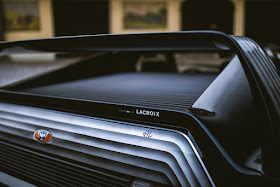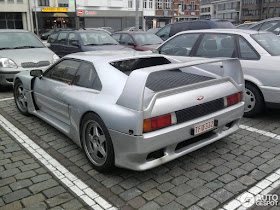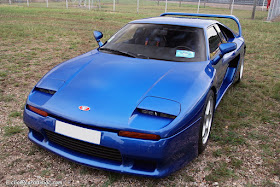The first Venturi came out in 1984, created by Claude Poiraud and Gérard Godfroy, two former engineers at Heuliez. The goal was to present the only "Grand Tourisme" French car capable of competing with the English Aston Martin, the Italian Ferrari, and the German Porsche. From the mid-1980s to the mid-1990s, they built mid-engined coupés and roadsters with turbocharged PRV (Peugeot Renault Volvo) engines and Renault gearboxes.
The 1994 Venturi 400GT was created to be a Ferrari F40 competitor. A limited-edition 400 GTR was built for the 24 Hours of Le Mans. It was recognized as the record holder of the fastest top speed ever attained at Le Mans: 407 km/h (253 mph). The 400 GT was the road-use homologation special built in order for Venturi to compete at Le Mans. Venturi took their Atlantique design, modified it heavily for racing—and then converted the specifications back for road use. Behind the seats was a DOHC 3.0-litre PRV-V6 with twin turbos that produced 408 hp and 384 lb-ft of torque. Weight was just 1150 kg (2538 lbs). Zero to 100 km/h (62 mph) came in 4.7 seconds, with a top speed of 291 km/h (181 mph). It was also the first car to be fitted as standard with carbon brakes. Venturi 400 GT remains just about the fastest French car ever made.
Between 1994 and 1996, thirteen Series 1 400GTs were made for racing homologation purposes, with an additional two Series 2 cars (with round tail lights and a few cosmetic differences) being completed in 1997. On top of that, 10 Venturi Trophys were retired from competition and converted to road use.
Venturi's almost unknown existence outside of France, under-capitalized and under-staffed state resulted in its bankruptcy in 2000, nearly sixteen years after its foundation, with fewer than 700 cars made. In 2001, Monegasque Gildo Pallanca Pastor purchased Venturi, and decided to focus on electric-powered engines. This change of direction led to the limited-production Fétish. (banovsky.com, automotiveviews.wordpress.com & wikipedia)
Venturi's almost unknown existence outside of France, under-capitalized and under-staffed state resulted in its bankruptcy in 2000, nearly sixteen years after its foundation, with fewer than 700 cars made. In 2001, Monegasque Gildo Pallanca Pastor purchased Venturi, and decided to focus on electric-powered engines. This change of direction led to the limited-production Fétish. (banovsky.com, automotiveviews.wordpress.com & wikipedia)




























































































